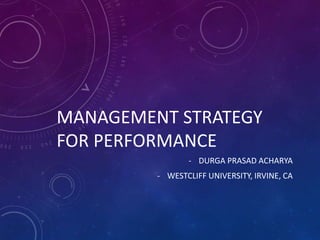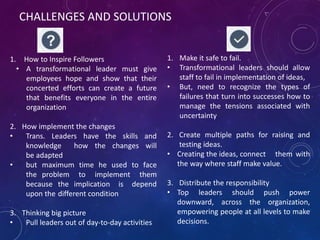Bus. 730 presentation durga
- 1. MANAGEMENT STRATEGY FOR PERFORMANCE - DURGA PRASAD ACHARYA - WESTCLIFF UNIVERSITY, IRVINE, CA
- 2. OBJECTIVES OF THIS PRESENTATION • Presenting the major concepts I learned from this course (Example, advantages, challenges and solution, application in the business) • (Crowdsource, Transformational leadership and expectancy theory) • Presenting the ideas of how I am going to apply them professionally • And, identifying the key elements of practical leadership
- 3. 1. CROWDSOURCING Example - LEGO, a toy company established on August 10, 1932, @ Billund, Denmark - Fans submit the product design which is voted by the open community. - When 10000 votes count, the product moves for production. - LEGO pays 1% royalties of worldwide sales to the creator - It allows LEGO to develop its product while simultaneously testing the product’s potential popularity
- 4. ADVANTAGES OF CROWDSOURCE 1. Unexpected solutions to tough problems • The most significant benefit of using crowdsourcing is the ability to find unexpected solutions 2. A greater diversity of thinking • Putting a wider pool of people to work can also unlock a greater diversity of thinking, as well as unexpected ideas. 3. A reduced management burden • Putting a wider pool of people to work can also unlock a greater diversity of thinking, as well as unexpected ideas.
- 5. CONTD. 4. More marketing potentiality • Because it’s an engaging public spectacle, crowdsourcing can be a great source of marketing potentiality. 5. Faster problem solving • Crowdsourcing isn’t just about getting access to the best ideas – it’s also about finding ideas as quickly as possible. 6. A rich source of customer data • Crowdsourcing also offers businesses and organizations a detailed window into their most dedicated fans and customers.
- 6. 1. Receiving Low-quality Work • You are putting your faith to the people that you don't know their skills, qualification or creativity. 1. Disorder the Business • “Turbulence risk" —the risk of engaging in the unknown in an environment where risk-taking is not necessarily encouraged 1. Find the high-reputation partner • Be ensure that they have a strong relationship with their members and a process for measuring quality. 1. Apply the 3Cs • Capability, (Judge which part your staffs can handle and which cannot.) • Capacity (Do your staffs have strength to handle the project?) • Calendar (Outline your timeline, and decide if you can meet this timeline with crowdsource.)
- 7. IMPLEMENTATION OF CROWDSOURCE 1. Have a team of people to create and manage the project, 2. Create a plan around what I want to accomplish, which included • Goal: What is the problem I would like crowd help to solve? • Execution: Decide what type of crowdsourcing I am planning to use (Eg:- surveys, a contest, data collect etc.) • Incentive: This could be financial or a specific kind of recognition • Security and Compliance: how I am going to keep my ideas protected 3. And, how I plan to use the crowd to do.
- 8. IMPLEMENTATION OF CROWDSOURCE Accepting the Ideas Archive Stage Fund Stage Review Stage Estimate Stage Refine Stage Team Evaluation Selecting the best ideas Estimate cost and benefit After review by expert, choosing the wining ideas Allocation of fund for the project Kept for later review
- 9. 2. TRANSFORMATIONAL LEADERSHIP • Example • Warren Buffett- CEO and largest shareholder of Berkshire Hathway • Buffett has employed a laissez-faire or free reign approach to managing his company • He gives the people who work for him a lot of leeway and freedom • He knows that people perform best when given autonomy • Admit mistakes yet stay humble
- 10. ADVANTAGES OF TRANSFORMATIONAL LEADERSHIP 1. Lower Turnover Costs • The transformational leader fully engages with people and seeks to satisfy their needs right along with the organization's needs 2. Responsive to Change • The transformational leader empowers employees to makes changes in themselves and realize their full potential 3. Better Outcomes from Corporate Learning The transformational leaders tend to improve the outcomes of existing employees and equip new employees for productive work.
- 11. CHALLENGES AND SOLUTIONS 1. How to Inspire Followers • A transformational leader must give employees hope and show that their concerted efforts can create a future that benefits everyone in the entire organization 2. How implement the changes • Trans. Leaders have the skills and knowledge how the changes will be adapted • but maximum time he used to face the problem to implement them because the implication is depend upon the different condition 3. Thinking big picture • Pull leaders out of day-to-day activities 1. Make it safe to fail. • Transformational leaders should allow staff to fail in implementation of ideas, • But, need to recognize the types of failures that turn into successes how to manage the tensions associated with uncertainty 2. Create multiple paths for raising and testing ideas. • Creating the ideas, connect them with the way where staff make value. 3. Distribute the responsibility • Top leaders should push power downward, across the organization, empowering people at all levels to make decisions.
- 12. IMPLEMENTATION OF TRANS. LEADERSHIP 1. Intellectual Stimulation • Turning me moments into we moments. • Leaders foster an environment where it's safe to have conversations, be creative and voice ideas, a place where all team members feel valued. 2. Individualized Consideration • People are different and what motivates and excites you is different from your peers and coworkers. 3. Inspirational Motivation • Leaders should make proud staffs what they are doing is not only a task, but it is the great change of the company or even country. 4. Idealized Influence • Need to be a mentor of sorts and lead by example • Values-based leadership is necessary 5. Perseverance Through Conflict • Need to be a mentor of sorts and lead by example • Values-based leadership is necessary for transformational leaders
- 13. 3. STAFF MOTIVATION – EXPECTANCY THEORY • Theory of hope • “Everything that is done in the world is done in hope” – Martin Luther King • Example • Apple Incl- Established in Cupertino, California on April 1, 1976 and incorporated January 3, 1977 • Steve Job-- motivate the team as a whole instead of just managing his staff, • He believed his employees could be great and he wanted to see them succeed • Motivates the employees to achieve the goals which are measurable, attainable and specific, • Employees attempt to increase their job performance level to get the valued rewards. • Eg- The company rewards its employees by giving them a reward bonus around 3% to 5% of their base salary, unless they fail to achieve their target, • Apple Inc. employees received $500 off of a Mac or $250 off of an iPad Team Cook- CEO of Apple Incl.
- 14. EXPECTANCY THEORY (M=E*I*V) • Expectancy: Is a belief that working hard will lead to achieving a desired level of task performance, • Instrumentality: a belief that good performance will lead to rewards and other potential outcomes, • Valence: the value that is associated with a reward and other outcomes
- 15. ADVANTAGE OF EXPECTANCY THEORY • Based on self interest and applicable for people who want to achieve maximum satisfaction • Emphasizes on rewards and other ways of recognition • End goal in this theory for any individual is to gain the most satisfaction and the least amount of pain • Accounts for differences that might occur between choices of people (Everyone is different) • Focuses on the fact that people can be motivated to do something if they know they are receiving an award for doing the task.
- 16. APPLICATION IN THE INDUSTRY 1. In recruitment and Selection • Recruitment panel should deserve to find the best candidate from the crowd who is motivate to foster organizational objective, 2. Interview Techniques • Develop a line of questions to determine how potential candidates will react to certain workplace situations • Interviewees study company literature and sharp the presentation of expectation so that they will impress the company’s hiring 3. Interview Employee Performance in Anticipation of Employer Response • Employee wants something from their company for their hard work. • The response could be a pay bonus or award.
- 17. KEY ELEMENTS FOR LEADERSHIP • “Anyone in a management or supervisory role is a leader, but not everyone in those positions exhibits true leadership”-Ashira Prossack. 1. Coaching, not directing 1. A great leader is a teacher and a coach, not a dictator 2. To be a great coach, I must understand that everyone has different needs and that there isn’t a one size fits all solution 3. Learn how my team members work best, and tailor my coaching to match their work style.
- 18. CONTD. 2. Being adept • Great leaders are prepared for change to happen at any time, • As a leader, I should very aware of everything that’s happening from a process standpoint as well as a people standpoint 3. Respect • Show my team respect through trust, • I should allow my employees to take risks and accept that they will fail sometimes. • My personal leadership style will command how often I do this. 4. Being a master communicator • A leader must be an excellent listener, in order to truly understand the needs of their team. • I should understand that different situations call for different communication styles, and are able to switch between them with ease
- 19. THANK YOU
Editor's Notes
- The most significant benefit of using crowdsourcing is the ability to find unexpected solutions. Putting a wider pool of people to work can also unlock a greater diversity of thinking, as well as unexpected ideas. No need of the leaders to lead the project, instead people from the world lead
- Because it’s an engaging public spectacle, crowdsourcing can be a great source of marketing potentiality. Crowdsourcing isn’t just about getting access to the best ideas – it’s also about finding ideas as quickly as possible. Crowdsourcing also offers businesses and organizations a detailed window into their most dedicated fans and customers.
- Disorder of the business : In other words, your full-time team might have some big questions — and hesitations — about the idea. If individuals and leaders in your organization aren't fully committed to crowdsourcing, it's hard to implement successfully. Capability : Determine which parts of the project your internal teams are capable of tackling, and which parts they aren’t. Capacity : For the internal folks that are capable of working on things, make sure they have the capacity to do it. Calendar : take a look at the calendar to outline your timeline for the project and decide if it makes sense to expedite some (or all) of the project with crowdsourcing
- Accepting the ideas: this can include design ideas, suggestions, and more. Team evaluation : Once the process of ideation has begun, the most promising ideas are evaluated by your team – or, if you have several complex ideas to review, one team is assigned per idea.


















